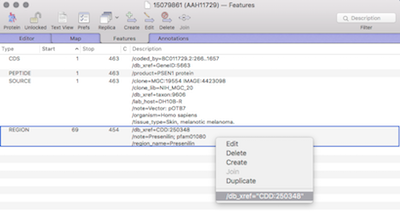Tag: databases
-

MacVectorTip: Viewing external database entries for features in a sequence.
Sequences, or regions of sequences, can be linked to external databases. For example an entire sequence entry or for when annotation tools are used to annotate proteins with domain or motif information (for example InterProScan). Very useful for when you want to view more detailed or updated information. Within the Genbank specification, which MacVector extensively…
-
MacVector’s Primer Database – Importing primers from Excel
Many molecular biologists keep lists of their primer sequences in Excel or some other spreadsheet tool. Previously MacVector had a separate utility that allows you to import primers kept in spreadsheet format into a Primer Database for direct use within MacVector. With the release of MacVector 18.2 we have integrated this functionality within MacVector. Rather…
-
Pasting tabular data from MacVector into Microsoft Excel
There are a number of MacVector analyses that generate tabular text output. Examples include the Protein Analysis Toolbox List output, the Raw Data tab of the ABI chromatogram document window, the Matrix tab of the multiple sequence alignment document windows and the Coverage tab of the Bowtie contig editor. Each of these is actually composed…
-
Viewing external database entries for features in a sequence.
Sequences, or regions of sequences, can be linked to external databases. For example an entire sequence entry or for when annotation tools are used to annotate proteins with domain or motif information (for example InterProScan). Very useful for when you want to view more detailed or updated information. Within the Genbank specification, which MacVector extensively uses,…
-
Downloading hits from the MacVector 15.5 BLAST Map results tab
The MacVector 15.5 BLAST Map results tab is a unique interface for examining the annotations around hits to a query sequence. Each pane in the display represents a High Scoring Segment Pair, as seen in the BLAST Aligned Sequence tab. At the lower left corner of each pane is a Download button – when you…
-
Use the BLAST Map to better identify blast hits
With the advent of cheap Next Generation Sequencing technologies, there has been an explosion of whole genome sequences deposited in BLAST databases. One consequence of this is that, particularly for sequences of bacterial origin, most of the significant hits are to entire genomes. The classic BLAST results show the sequence alignments, but give no indication…
-
Viewing external database entries for features in a sequence.
Sequences, or regions of sequences, can be linked to external databases. For example an entire sequence entry or for when annotation tools are used to annotate proteins with domain or motif information (e.g. InterProScan). Very useful for when you want to view more detailed or updated information. Within the Genbank specification, which MacVector extensively uses,…
